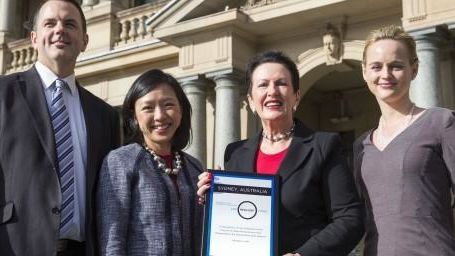 Associate Professor Tobias Kretzschmar with a black rice diversity panel growing in the polytunnel facility at NSW DPI Wollongbar.
Associate Professor Tobias Kretzschmar with a black rice diversity panel growing in the polytunnel facility at NSW DPI Wollongbar.
Across the globe it’s labelled a superfood and now trials of black rice grown in the Australian subtropics is the focus of a $600,000 ARC-funded research project at Southern Cross University.

Black rice unhulled (foreground) and hulled.
Southern Cross Plant Science Associate Professor Tobias Kretzschmar is leading the six-person research team to determine drivers of nutritional quality in black rice – a food which shares the same naturally occurring ‘superfood’ compounds as blackberry and acai.
This new critical knowledge will enable future breeding of quality black rice cultivars that can exploit the growing environments of subtropical and northern Australian to enable domestic production of high-value, healthy black rice.
“The demand for functional foods with health benefits, including black rice, is increasing both domestically and internationally,” Professor Kretzschmar said.
“While high UV levels in Australia are often viewed as a negative climactic factor, this radiation may actually have an advantage in boosting the accumulation of healthy compounds in optimised black rice, making Australia – and specifically the NSW Northern Rivers – well placed to produce the highest quality black rice.”
Black rice gets its dark colour from a range of naturally occurring compounds called ‘anthocyanins’ which are known to be beneficial agents in reducing inflammation, and has major antioxidant properties. Importantly they have the potential to reduce the GI (glycaemic index) of rice.
Associate Professor Kretzschmar has worked with rice for more than 10 years, including at the International Rice Research Institute (IRRI) in the Philippines, where the International Rice Genebank (IRG) houses more than 100,000 types of rice, before joining Southern Cross University two years ago.
This black rice project involved identifying 300 black rice lines from that collection, which originate from 19 countries across Asia and Africa.
“We had screened the vast IRRI genebank for purple and black rice accessions and these were imported into Australia in January last year. They then had to pass strict biosecurity measures, where they were grown for one full generation, from seed to seed, and tested for possible contamination under quarantine. So far 256 lines have been released,” Associate Professor Kretzschmar said.
For the first time these black rice lines will be grown in Australia, with the backing of the Australian Research Council Linkage program.
“When combined with local germplasm we will have more than 300 lines to be trialled. The most important part of the project is characterising this unique genetic resource, to resolve how the interaction between crop genetics and the growing environment drives the concentration and composition of nutraceutical compounds in black rice,” said Associate Professor Kretzschmar.
“This project will pave the way for the development of a profitable crop alternative for farmers in the subtropics and northern Australia. In the long term this has the potential to improve farm income and increase the financial sustainability of farming businesses, while also creating supply chains in processing and packaging in regional and remote areas.”
Australia’s southern Riverina region already produces high quality rice. However, the pigmented rice is a niche crop with growth potential in domestic and international markets.
“The project will also provide critical genetic and nutritional information for future breeding of high- value ‘healthy’ rice to help meet the national targets of improving the health of Australians,” said Associate Professor Kretzschmar.
Southern Cross Plant Science is based at the University’s Lismore campus in the NSW Northern Rivers region.
Professor Bronwyn Barkla, Director of Southern Cross Plant Science, said this project will benefit from the centre’s strong expertise in the area of plant chemistry and will be supported by the University’s recent investment in high-end analytical equipment.
Australian Research Council Linkage LP190100468 – $604,841
Project summary
New critical knowledge will enable future breeding of quality black rice cultivars that can exploit the high UV Australian growing environment to enable domestic production of high-value, healthy black rice. The demand for functional foods with health benefits, including black rice, is increasing both domestically and internationally. The concentration of key functional compounds in black rice may be increased by growing optimised cultivars under high-UV radiation, making Australia well placed to produce the highest quality black rice. Utilising a unique genetic resource this project will resolve how the interaction between crop genetics and the growing environment drives the concentration of functional compounds in black rice.






